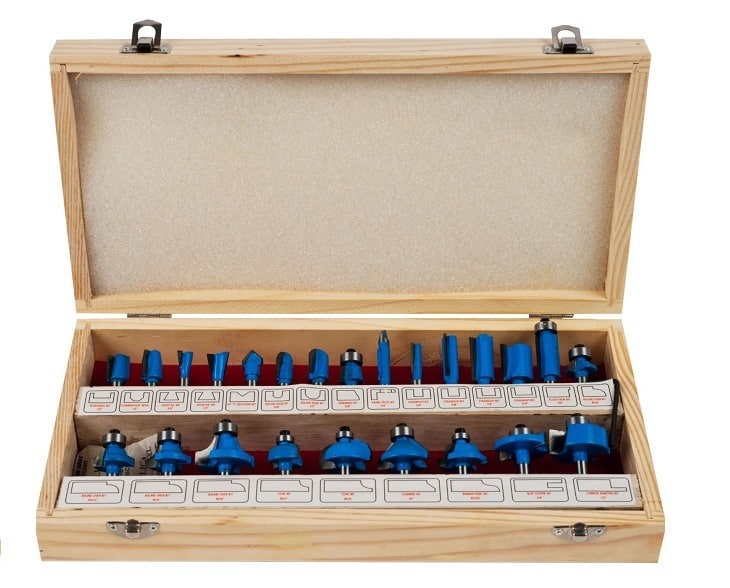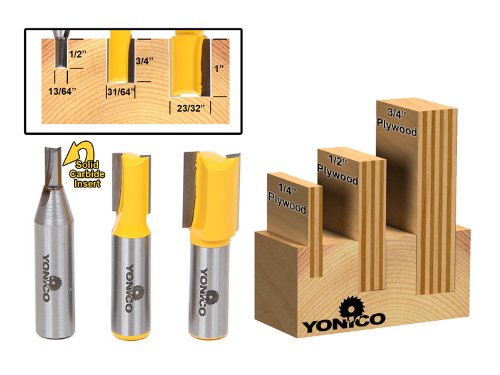Definite Guide for Choosing the Wood Router Bits
You have eventually acquired your new wood router, and you are quite excited about using it. The tool as highly sophisticated as it is, is toothless, no bits. You need these bits but where and how do you begin? For beginners, the task of selecting the wood router bits proves to be a hard nut to crack. Before we get into the details lets first shed a light unto what we are talking about by defining what a router bit is in the first place.
What is a router bit?
It is a cutting tool that is used alongside a router to hollow out some spaces on the surface of a hard piece of work. They are widely used in woodworking applications such as carpentry and cabinetry. Furthermore, they are useful also for working on plastics, metals, and other materials. They are ideally used in creating joinery aids and garnish pieces of work with ornate effects on formed edges, surfaces of the piece of work, and many others.
Router bits are highly versatile, and with the right router bits the woodworker can cut, shape, or trim a piece of work into whichever form he/she desires. The bits come in various designs and sizes. However, they can be customized to create any profile possible.
Bit profiles to choose from
Bits come in various designs and sizes but all of them serve the same general purpose, so to speak. Wood router bits may be similar but each one can handle a different thing and deliver unique results.
An ideal router bit, however, should be sharp, and its sharp edge should have the ability to last long. It should also be properly balanced so as to avoid unnecessary vibration or “chatter” when in use, and also ensure the bit does not wear out easily. It is commonly noted that bits of lesser quality never last long, chip faster and vibrate excessively when in use. The following is a guideline when choosing wood router bits:
- You have to consider the profile that you want. Simply put, the profile refers to the shape of the cutting edge. The most common profiles to choose from are listed below:
- Rabbeting Bits – Are bits specially designed for cutting a rabbet or shoulder in the edge of a piece of work. Oftentimes they are used for joining pieces. These bits are usually directed by a rotating pilot bearing on their tip. They are usually available in various sets that have bearings of different diameters. This enables a single bit generate rabbets of different sizes.
- Flush-Trim Bits – As the name suggests, they are bits used for trimming the edge of one material flush using the edge of another. They have a pilot bearing with an equal diameter to the cutter. The bearing can either be on the tip or on the base.
- Straight Bits – Are bits that create cuts straight into a piece of work to generate a groove or dado. It basically forms a hollow for inlaying. Straight bits are designed with varied diameters and lengths.
- Specialized Bits – These are basically bits designed for specific tasks. Classical examples of these type of bits include molding bits, stile-and-rail bits, and raised-panel bits;
- Molding bits – combines multiple edge-forming profiles to one single bit.
- Stile-and-rail bits – for shaping frame pieces in panel and frame constructions, for examples, cabinet doors.
- Raised-panel bits – are ideally bits that shape the door panel edges and ensure it fits perfectly with the corresponding frame stiles and rails slot. They are a bit larger and only work safely on a mounted table router.
- Others – finger-joint, dovetail bits, lock-miter, and drawer-lock bits.
- The need for mounting the router: This should form a basis of your judgment when deciding which wood router bits to select. Try to figure out whether you will be mounting the router on a table when doing some tasks or you will make handheld cuts. Some bits can only be operated safely on a table-mounted router. For instance, when designing a frame-and-panel cabinet piece of work, you will definitely have to build a router table prior to using stile-and –rail bits that are perfect for such kind of work.
- Consider the quality: Make use of visible signs of quality. Choose bits with carbide cutters and that have been sharpened to produce a fine edge. They should also be thick enough to facilitate regrinding. Furthermore high quality bits have anti-kickback properties. They are ideally thick and have enlarged bodies to avoid the bits from biting deeper than expected or even catching on the material. More body mass also help in eliminating excessive heat and keeps the bits sharp for longer.
- The size of the router bit shanks (1/4 inch or ½ inch): This is a factor that should be in mind when making your choice. Even though some bits accept ¼ inch shank bits or ½ inch shanks only, you may find some routers that have interchangeable ¼ and ½ inch collets so that both may be used. ½ inch shank bits are mostly preferred since they offer better stability with minimum vibration. They also give a smoother cut and last for longer.
- Consider the price: As the case always is, you will definitely get what you bargain for. Every wood workman understands this fact and uses price as a measure of quality. You must strike a balance between getting the best quality and settling on the most competitive price as well. Trying to compromise on quality just because you need a cheaper one never comes cheap. You will later on incur maintenance, replacement, and miscellaneous costs. Ensure you buy wood router bits that are made from high quality carbide and sharpened using strong materials. Your ideal bits should be able to deliver smooth and safe cutting for an extended time period.
Summary – Take home tips
- Ideal router handling practices should be adhered to, for instance, avoid forcing a bit or moving a bit too slowly since this can cause bit and router overheating. Overheating damages the piece of work and can cause irreparable internal damage.
- To prevent unwarranted damages on the piece of work, always keep the router bits sharp. Dull bits produce poor cuts and damages the materials.
- Finally, keep router bits separate from one another, if possible on separate cubbies. This will help avoid damages since router bits are fragile.


